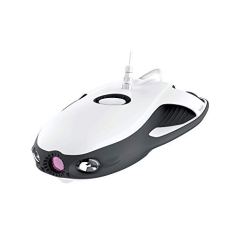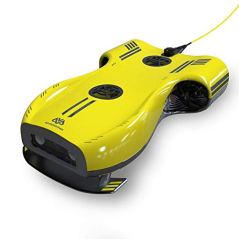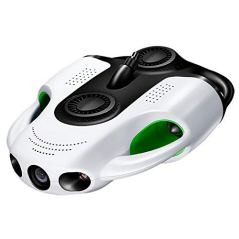BestReviews is reader-supported and may earn an affiliate commission. Details

While some may find it expensive, this customer favorite is designed with deep water access and video in mind.
While some may find it expensive, this customer favorite is designed with deep water access and video in mind.
Features a 492-foot tether and 3,000-lumen lighting to enhance photography and video in deep water. Six thrusters, smart hovering, and a self-balancing feature help improve maneuverability and image quality. Camera supports 4K video and 8MP photographs. Four-hour battery life.
It’s one of the pricier drones in this niche.

This cool-looking drone is remote-controlled and sonar-equipped. Capable of delivering 4K video at depths up to 98 feet.
This cool-looking drone is remote-controlled and sonar-equipped. Capable of delivering 4K video at depths up to 98 feet.
High-definition camera captures all the underwater action with a 100-degree wide-angle lens. Boasts 128 GB of storage and chugs along at a decent clip of several knots. Even can drop bait remotely.
May not be worth the cost for some.

This popular drone is the gold standard for recreational use. Capable of real-time streaming in high definition at depths to nearly 100 feet.
This popular drone is the gold standard for recreational use. Capable of real-time streaming in high definition at depths to nearly 100 feet.
Drone camera supports 4K streaming and has 64 GB of storage. Operates on a 230-foot tether.
Though not the most expensive choice, it is still pricey and not to be confused with a toy.

This drone stands out for its quality photography and video. It also has some great extras, like its tether reel.
This drone stands out for its quality photography and video. It also has some great extras, like its tether reel.
Camera supports 4K video and takes 16MP photographs. Includes an app for use with iPhone or other devices. Can be used up to 3 hours per charge. Drone camera includes a variety of special features, including an underwater filter. Ships with a reel and 328 feet of tether.
Some buyers report issues using this drone in salt water.

This drone can stay under for up to 5 hours at a time, and we love the easy-carry handle built into it.
This drone can stay under for up to 5 hours at a time, and we love the easy-carry handle built into it.
Resists corrosion. Has a built-in handle for easy carrying. Camera supports 1080p video and 12MP photographs. 64GB storage capabilities. Has a 328-foot tether.
The base camera is not as powerful as other drones, although you could upgrade to 4K and zoom features for almost double the cost.

We recommend these products based on an intensive research process that's designed to cut through the noise and find the top products in this space. Guided by experts, we spend hours looking into the factors that matter, to bring you these selections.

Flying drones have captured the imagination over the past few years, with sales surging to the point that government agencies such as the FAA have had to step in to regulate the use of them. It was only a matter of time before this hobby pulled a bit of a reverse evolution and returned to the sea in the form of the next consumer tech phenomenon: underwater drones.
Much like their airborne brethren, underwater drones are designed for exploration, with remote controls that allow users to guide them and cameras to record it all. These drones range from simple submersibles to professional-level drones that can be used by researchers and aquatic industries, and, as such, shopping for one can quickly get overwhelming.
This buying guide covers the features and other considerations you need to be aware of when shopping for an underwater drone. These drones can be pricey, so we also cover what you will find at various price points.

Underwater drones can seem like they’ve floated right out of a sci-fi movie. While some are designed to resemble fish, the majority offer a submarine-like design with smooth contours to improve speed and maneuverability. Some underwater drones also come in bright colors, such as yellow, which helps them stand out in the water.
When shopping for an underwater drone, pay special attention to each drone’s capabilities, and line them up with your interests. This is a relatively new niche, and manufacturers by and large design and sell to specific demographics.
While nowhere near the size of the drones that explore the Mariana Trench in the Pacific, consumer underwater drones still have some heft to them. Ranging in size from a foot to a couple feet in length, they tend to be a bit larger than airborne drones. They also weigh more, with some tipping the scales at over 20 pounds.
Tethered: Most underwater drones use some form of tether system, usually attached to a floating module that in turn connects wirelessly to a remote, smartphone, or VR goggles. There are two reasons for a tether. First, radio signals don’t travel effectively through water. A tether allows you to control the drone better and is the only way to livestream quality video. Second, a tether also keeps your drone from disappearing into the depths if it runs out of power or goes out of range. Tethers come in a variety of lengths, with 165 to 328 feet as standard. The length of the tether also determines how deep the drone can dive.
Untethered: There are some wirelessly controlled underwater drones, but these are rare and usually only used in shallow water. Other drones are autonomous, capable of following you around and recording video as you swim or scuba dive. If you do much solo diving, this might be the type of underwater drone for you.
The thrusters, camera, and other equipment on all underwater drones are powered by batteries. The run times vary from 1 to 8 hours. The longer the run time, the longer you can use the drone before having to recharge the batteries. Some underwater drones are designed so you can easily swap out batteries without taking the drone out of the water.
In addition to run time, check out how long it takes to recharge the battery. Backup batteries for underwater drones are usually sold separately.
While underwater drones vary in terms of speed, most peak at around 4 to 5 miles per hour, or about 2 meters per second. Note that this is cruising speed. When the thrusters need to work for the drone to ascend or descend, the speed could be as much as 80% slower.

Underwater drones move in the water with thrusters, or propellers. These propellers move the drone forward and in any other direction the drone can go. Underwater drones have at least two thrusters, with four or six being standard. The more thrusters, the easier it will be for the drone to maneuver in the water. Some underwater drones shaped like fish are propelled by an actuating rear fin.
A camera is standard on underwater drones. It serves as your eyes underwater and as a great way to record all the sea life that the drone encounters.
Underwater drone cameras are typically 4K, capable of both streaming and taking still shots that can range from 8 to 16 megapixels, depending on the drone. Still image and video storage on a drone can range from 32 to 128 gigabytes. Wide-angle lenses are quite common here, too, with some cameras also incorporating a variety of other features, such as image stabilization or color-correction filters, to improve image quality.
Manufacturers provide apps so you can use your smartphone with the drone, and some also design their drone to be used with VR goggles. These provide you with an immersive experience, but they can also be used to navigate via gestures.
It can be dark underwater, so some drones have LED lights on the front to navigate the depths, as well as shoot clearer stills or video. The lights, either single or in pairs, typically range from 2,000 to 6,000 lumens.
Underwater drones typically include a variety of elements to improve their performance in the water. Some use built-in sonar to provide information on the aquatic environment, including depth and ocean floor topography. Others use sensors to return information on the water temperature or even to avoid obstacles, so the drone can be used around delicate reefs without damaging them.
As mentioned, underwater drones can be fairly expensive, so you should definitely know what features and capabilities you’re purchasing before parting with your money. They start at around $500 and can reach $3,000 or more. Most fall in the $1,000 to $2,000 range.
At the lower price points, the entry-level drones have a number of the capabilities of more expensive underwater drones, but they offer less in the way of range, performance, and advanced features. Still, if you want to try this fascinating hobby, it’s an affordable way to get your feet wet.
Pay more and you’ll find options that take full advantage of everything these drones can do. Longer tethers allow you to take the drone farther and deeper, while more powerful thrusters, batteries, and cameras propel you there faster, keep the drone underwater longer, and provide higher-quality video and stills. You’ll also find more advanced features, such as the ability to use VR goggles, on pricier underwater drones.

Choose the right drone for video. Do you primarily want to use your underwater drone to stream high-quality video? Due to the fact that radio signals travel so poorly through water, your best bet is to purchase a drone that’s equipped with a tether.
Choose the right drone for social media. If one of your primary reasons for buying an underwater drone is to create photos and videos that you can post on social media, be sure that the drone includes an app that works with your particular type of smartphone or device.
Choose a drone you can add on to. This will allow you to enter the underwater drone world fairly inexpensively and then add cameras, sensors, and other components as your interest grows.
Conserve battery life. To conserve the battery life on your underwater drone, try taking still shots instead of more energy-draining video.

Q. Can an underwater drone be used for fishing?
A. Any underwater drone with a camera can be used to scope out a fishing spot before casting your line, but some offer a number of features that can vastly improve your ability to catch a fish An underwater drone with sonar can provide you with valuable information on the ocean landscape, depth of the water, and even serve as a fish finder. Sensors on an underwater drone can return information about water temperature, which will indicate the type of fish you’re likely to catch. And some underwater drones go the extra mile with specialized fish hook holders that allow you to drop bait exactly where you want it to go.
Q. What are some of the practical uses for an underwater drone?
A. If you’re in search of something more concrete than a really cool hobby, consider some of the numerous ways you can use one. We’ve mentioned fishing, but underwater drones can also be used to inspect the bottom of a boat and other underwater structures. Filmmakers and video buffs will find an underwater drone indispensable for taking underwater shots, as will anyone with an interest in aquatic research or ocean floor mapping. An underwater drone can also be a critical element of underwater search and rescue operations. And don’t forget treasure hunting!
Q. Since these drones often use a long tether, do they also come with some form of reel?
A. A reel is handy for retrieving the drone and storing the tether when it isn’t in use. Some underwater drones do include a reel to manage the tether. Other manufacturers don’t include one but have reels available as accessories to purchase separately. Contact the seller or manufacturer to find out if a reel is available and how much it costs.
Get emails you’ll love.
Learn about the products you’re wondering if you should buy and get advice on using your latest purchases.
